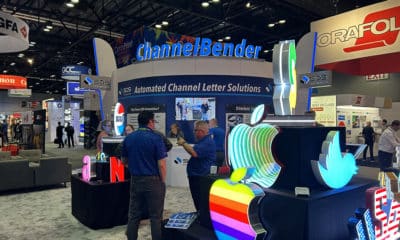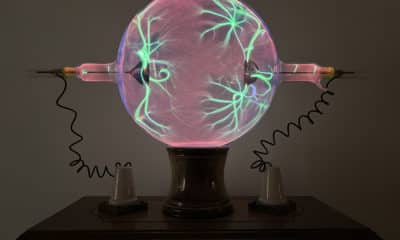When Philadelphia Sign Co. (PSCO) was founded in 1911, wooden, handpainted “For Rent” signs represented its first offering. As neon’s introduction to the sign industry revolutionized electric-sign possibilities, the shop became an early adopter and built numerous movie marquees and rooftop signage as they became industry trends. The company has since kept pace with LED illumination and other signage innovations. As ST can attest (it passed the century mark five years ago), an enterprise doesn’t remain in business for 100 years without rolling with the punches and staying vigilant in adopting new trends. Today, the shop provides turnkey manufacturing, project management and maintenance for financial-services, retail and hospitality clients, among others.
Embarking on its second century, PSCO now maintains headquarters in Palmyra, NJ, just outside Philadelphia. It operates additional production facilities in Palmyra and Pennsauken, NJ, as well as a sales and installation plant in Littleton, MA, and satellite sales offices in Chicago and Knoxville and Virginia Beach, VA.
The company boldly addressed what will be a growing concern for the next 100 years – sustainable energy. The company equipped its 225,000-sq.-ft. Pennsauken facility with a $4.5 million retrofit that enables the shop to be run entirely by solar power. What began as a cold call evolved into a forward-thinking decision to invest in green energy.
Here comes the sun
During the summer of 2010, several solar-power-component vendors visited PSCO to discuss installing a solar-power system. Intrigued by both investing in renewable energy and federal tax credits, Bob Mehmet, PSCO’s CEO, researched the viability and efficacy (and cost) of switching to solar power. He exhaustively pored over data for two months, and toured nearby facilities – Dietz & Watson, Johnson & Johnson and the Pennsauken landfill – which had transitioned to solar power. Mehmet then decided to state his case to Bill Trucksess, the company chairman. Trucksess agreed the solar-power installation would be advantageous.
Rather than going with a turnkey provider, PSCO decided to buy its components directly from the manufacturer and manage the project in-house. They chose to retrofit the Pennsauken plant because its flat roof, which spans approximately five acres, would be most conducive to the changeover. The company promptly sought project vendors.
Advertisement
Mehmet said, “As with finding a sign-industry vendor, it became very apparent that there’s a significant difference in quality among manufacturers.”
A week later, PSCO contracted with Array SunSystems (Pennsauken), a company that constructs solar-integration systems, and First American Solar, also of Pennsauken, as the project’s installer. After Array SunSystems conducted a site survey to determine the facility’s needs, PSCO purchased 4,790 Mage Solar photovoltaic (PV) cell panels and two SMA 500,000W, DC-to-AC power inverters.
The panels’ semiconductor layers, which comprise crystalline silicon, absorb light and transfer the light’s energy to the PV cell. The energy loosens electrons, and their movement produces a direct electric current (DC). The inverter runs the DC through a transformer, which converts it into alternating current (AC), which provides the more mobile, bi-directional current required for virtually all commercial electrical usage.
Before the PV panels were installed, PSCO applied a white, thermoplastic-polyolefin (TPO) coating to the roof, which directs sunlight away from the surface and toward the panels, which increases the PV output by approximately 50%.
Built in the 1930s, the Pennsauken facility is, in Mehmet’s words, “built like a tank.” The roof is framed in steel and covered by 1.5-in.-thick, wood planks. So, it was more than strong enough to handle the coating and panels’ additional weight.
Green thoughts
Advertisement
Although the “green energy” change provided the somewhat intangible benefit of conserving energy and enjoying industry-pioneer status, the switchover tangibly bolstered PSCO’s bottom line. John Foley, the company’s senior VP, said, “Our comptroller was pleasantly surprised when our monthly electric bills were nearly $16,000 less per month than the year before, despite increases in manpower and overhead.”
The PV installation is tied into the plant’s electric grid through a system called net metering. The electricity meter records the amount of electricity being fed back into the power grid, and credits for kilowatt-hours (kWh) used are applied to the customer’s account. Mehmet said that, since the system’s completion in early 2011, power the company’s PV system has sent back to Public Service Electric & Gas of New Jersey has exceeded the power the company has consumed by 50,000 kWh – the equivalent of power used at its Palmyra production facility. The costs for insurance and maintenance of the system amount to less than 10% of the company’s utility bills annually. Moreover, the solar panels’ energy generation offsets enough carbon pollution to equal the removal of 6,400 cars, and their emissions, from the road.
In addition to the $190,000 yearly reduction on the power bill, federal tax credits for solar-energy usage have also benefitted the company. Put in place through the Section 1603 Treasury Grant program, the government allows owners of PV energy-collection systems to depreciate 85% of the system’s total operating costs during its first year, as well as a federal grant that allows the company to receive a tax credit through the U.S. Treasury equal to 30% of the system’s set-up costs. All told, the tax credits will save the company an estimated $1.3 million on its 2011 taxes. The timing was key; in 2012, the deprec-iation credit reduces to 50% at best.
“With the net-metering and tax credits, the system was a no-brainer,” Mehmet said. “And, after [the impact of Presidential and Congressional elections in] 2012, it’s unknown whether the alternative-energy credits will continue. It was time to act.”
PSCO reinforced its energy-efficiency initiative by replacing every 400W, metal-halide bulb in the plant with 200W, compact-fluorescent bulbs that fit the same fixtures. Bret Matthews, national sales VP, concluded, “The halls have never been brighter, and the reduction in energy usage has been substantial. The switch to solar also gives our customers the opportunity to affirm their commitment to renewable energy by purchasing their signs from us. This undertaking is a significant statement of where our company is heading in the next 100 years.”



 Tip Sheet1 week ago
Tip Sheet1 week ago
 Ask Signs of the Times3 days ago
Ask Signs of the Times3 days ago
 Photo Gallery1 day ago
Photo Gallery1 day ago
 Real Deal1 week ago
Real Deal1 week ago
 Benchmarks6 days ago
Benchmarks6 days ago
 Editor's Note2 weeks ago
Editor's Note2 weeks ago
 Women in Signs1 week ago
Women in Signs1 week ago
 Photo Gallery1 week ago
Photo Gallery1 week ago









